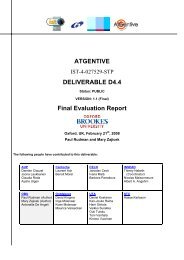pdf 820Kb - INSEAD CALT
pdf 820Kb - INSEAD CALT
pdf 820Kb - INSEAD CALT
You also want an ePaper? Increase the reach of your titles
YUMPU automatically turns print PDFs into web optimized ePapers that Google loves.
Evaluation report of the use of Onto-Logging<br />
platform in the user site<br />
Deliverable ID: D8b<br />
Page : 13 of 110<br />
Version: 1.0<br />
Date: 27 january 2004<br />
Status: Final<br />
Confid.: Public<br />
2.3.2 Observational methods<br />
Observational methods involve real people using working systems. They are based on<br />
observing users interacting with the actual system and can range from being almost entirely<br />
informal to highly structured. Observational methods should try to be as invisible as possible<br />
to the user.<br />
Direct observation. Users are observed directly doing special or ordinary task in their work,<br />
while the observer makes notes about the their behavio ur and performance that she consider<br />
important to record. The evaluators do not have direct contact with the user.<br />
Indirect observation and software logging. Videoing a user interaction with a system<br />
allows recording several aspects of the user activity. Combined with some forms of automatic<br />
keystroke or interaction logging enable to collect vast amount of data. In some cases,<br />
software-logging tools can be used to record time-stamped key presses and real time<br />
recording of the interaction between users and technology. Besides, in many cases,<br />
information systems are usually able to track and monitor the activities of the users and to log<br />
them (for instance, that a user has posted a document, or has launched a search).<br />
Think aloud protocol. The data collected by think aloud protocol contains users´-spoken<br />
observation by addressing the cognitive activity and provide a subjective feeling about the<br />
activity they are performing. Users are asked to think aloud to describe what they are doing at<br />
each stage, and why. The evaluators record the users actions by using tape recordings, video,<br />
or pencil and paper.<br />
Note: Of course, the think aloud protocol may not be considered as totally neutral on the<br />
activity of the user since it introduce a cognitive load that can dist ract this user.<br />
2.3.3 User’s Opinions methods<br />
The objective of the users’ opinion method is to elicitate the (subjective) perception of the<br />
system by the different categories of users.<br />
Structure interview. Interviews are particularly useful in eliciting information about user<br />
attitudes, impressions, and preferences. Interviews can be used in conjunction with thinkingaloud<br />
protocols for retrospective analysis of user responses and events.<br />
Questionnaires. Questionnaires have been used as instruments to assess different aspects of<br />
usability of the human-computer interface. Collecting users' subjective opinions about a<br />
system can remove unpopular and unusable parts early in the design or after delivery.<br />
Focus groups. Focus Groups are effective Research Tool and are very commonly used in<br />
software development. They are similar to interviews, but because we have a group of<br />
participants the group dynamics generate more data then one to one interviews. Focus groups<br />
involve gathering 8 - 12 members of a target audience for an open-ended discussion of
















